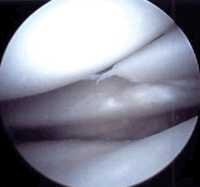Posterior lateral meniscus avulsion tears can be left in situ during ACL reconstruction
 K. Donald Shelbourne |
Leaving asymptomatic posterior lateral meniscus avulsion tears in situ at the time of ACL reconstruction provides good results, according to a 55-patient prospective study.
At 10 years, mild joint space narrowing was observed in both the study and control group, but there were no significant differences in subjective or objective findings, according to the study data.
“In orthopedics, we tend to be surgically oriented,” said lead author K. Donald Shelbourne, MD, of Indianapolis. “It is hard to decide when people need surgery and when you might be doing people harm by doing surgery.”
Nonsymptomatic tears
Shelbourne was inspired to undertake the study after contemplating how often he encounters a patient with a symptomatic tear of the posterior horn of the lateral meniscus. He realized the answer was never. “However these tears have to occur, if they are not causing problems, why are we trying to take them out?” he said.
Shelbourne noted that the posterior horn of the lateral meniscus is “a difficult spot to get reach. Trying to sew it back is challenging as far as scratching up the condyles. You have to pull the meniscus together, and then you can’t let the person bear weight. Then when the person bears weight, you are assuming the meniscus does not separate.”
|
Image: Shelbourne KD |
Similarly, attempting to remove the posterior horn of the lateral meniscus is difficult because, again, the condyles might scratch. “So am I helping the person or not by trying to do something?” Shelbourne told Orthopedics Today. “The hardest thing in orthopedics is sometimes to do nothing. But the assumption is that if you are doing something, that is better than doing nothing. Unfortunately, I have seen many people have harm done to them in an attempt to do something.”
Results of the study, which were presented at the 2010 Annual Meeting of the American Orthopaedic Society for Sports Medicine, found that when patients were evaluated subjectively using the International Knee Documentation Committee (IKDC) subjective knee evaluation forms, the mean IKDC total score was 84.6 in the study group compared with 90.5 in the control group of patients without meniscus tears.
Objective measures were ascertained from IKDC forms and digital radiographic measurement of joint space narrowing. Knee extension, flexion and KT-2000 arthrometer values were similar between the two groups.
In the study group, joint space was deemed mild narrowing in 30% of patients, moderate in 9% and severe in 3%. This compared to 15% mild narrowing and no cases or moderate or severe narrowing in the control group.
Overall, the measured amount of lateral joint space narrowing in the study group was 1 mm vs. 0 mm in the control group, based on 45· degree flexed posteroanterior radiographs.
Surprising results
“I thought that the outcomes would be worse because we are left with a meniscus that does not function nearly as well as a normal meniscus,” Shelbourne said. “I was afraid that we would cause problems by leaving it alone. Surprisingly, patients fared much better than anticipated. So I am comfortable with what we are doing.”
Patient recovery is more rapid and less expensive by avoiding meniscus repair. Otherwise, patients must use crutches (nonweight-bearing) “for weeks,” Shelbourne said. “This certainly keeps people out of work.”
Shelbourne also noted that a lateral meniscus posterior horn avulsion tear is a “unique tear that we observe only with anterior cruciate ligament tears.” – by Bob Kronemyer
Reference:
- Shelbourne KD, Roberson TA, Gray T. Long-term evaluation of lateral meniscus posterior horn avulsion tears left in-situ at the time of anterior cruciate ligament reconstruction. Presented at the 2010 Annual Meeting of the American Orthopaedic Society for Sports Medicine Meeting. July 15-18, 2010. Providence, R.I.
- K. Donald Shelbourne, MD, can be reached at Shelbourne Knee Center, 1815 N. Capitol Ave., Indianapolis, IN; 317-924-8655; e-mail: tgray@aclmd.com.
- Disclosure: Shelbourne is a consultant for DJO and Kneebourne Therapeutics and receives royalties from Cryo/Cuff.
![]() Follow
OrthoSuperSite.com on Twitter
Follow
OrthoSuperSite.com on Twitter

